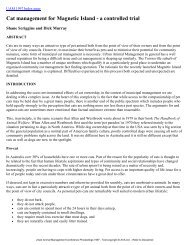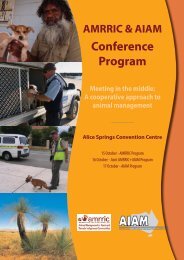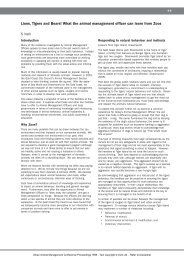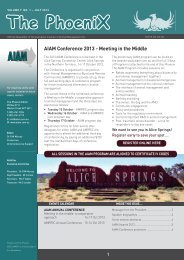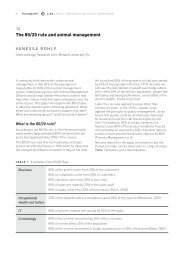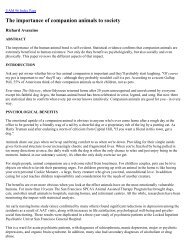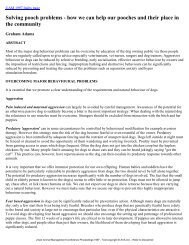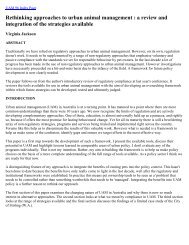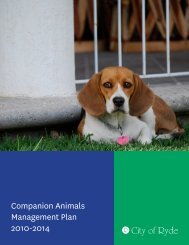Cat legislation in South Australia - Australian Institute of Animal ...
Cat legislation in South Australia - Australian Institute of Animal ...
Cat legislation in South Australia - Australian Institute of Animal ...
You also want an ePaper? Increase the reach of your titles
YUMPU automatically turns print PDFs into web optimized ePapers that Google loves.
UAM 95 Index page<br />
<strong>Cat</strong> <strong>legislation</strong> <strong>in</strong> <strong>South</strong> <strong>Australia</strong><br />
Deborah Kelly<br />
ABSTRACT<br />
A major problem <strong>in</strong> cat management is differentiat<strong>in</strong>g owned from unowned cats. The <strong>South</strong> <strong>Australia</strong>n Dog and <strong>Cat</strong><br />
Management Act, which was proclaimed on 1 July 1995, addresses this problem. A cat is legally owned if it is<br />
identified <strong>in</strong> accordance with the Regulations. Owned cats are protected unless they are <strong>in</strong> remote areas or with<strong>in</strong><br />
National Parks and designated sanctuaries. Unowned cats can, with the consent <strong>of</strong> the land holder, be removed without<br />
the risk <strong>of</strong> civil liability. Councils have the ability to <strong>in</strong>troduce byelaws to manage dogs and cats, should this be the<br />
wish <strong>of</strong> their residents.<br />
BACKGROUND<br />
The issue <strong>of</strong> cat control was <strong>in</strong>itially raised <strong>in</strong> the late 1980's. There was considerable concern, and a lack <strong>of</strong> consensus,<br />
surround<strong>in</strong>g a number <strong>of</strong> 'cat issues'. Some councils wanted to <strong>in</strong>stigate curfews and registration, others wanted to<br />
subsidise desex and release programs, and others wanted to play no role <strong>in</strong> cat management whatsoever. Some<br />
threatened to 'go it alone' if the State Government did not take the lead. As the magnitude <strong>of</strong> problems varied between<br />
areas, so did the attitude <strong>of</strong> the local councils. Some sectors <strong>of</strong> the community felt threatened by the possibility <strong>of</strong> <strong>Cat</strong><br />
Police and wanted some means <strong>of</strong> protect<strong>in</strong>g their pets, others wanted to be able to remove strays without threat <strong>of</strong> civil<br />
liability. It has long been recognised that too many lost, pet cats are euthanased because their owners never reclaim<br />
them. Conservationists emphasised the predatory nature <strong>of</strong> the cat but few people have seriously considered the<br />
benefits <strong>of</strong> pet ownership <strong>in</strong> general and <strong>of</strong> cats as pets <strong>in</strong> particular.<br />
The <strong>Cat</strong> Work<strong>in</strong>g Party Report was completed <strong>in</strong> 1992. This outl<strong>in</strong>ed the benefits and problems associated with cats <strong>in</strong><br />
<strong>South</strong> <strong>Australia</strong> and recommended several courses <strong>of</strong> action for the consideration <strong>of</strong> the government <strong>of</strong> the day. By<br />
1993, it was clear that no course <strong>of</strong> action would be universally acceptable. The pro-cat lobby firmly opposed any<br />
legislative controls, the anti-cat lobby wanted all the recommendations <strong>of</strong> the <strong>Cat</strong> Work<strong>in</strong>g Party Report to be<br />
implemented and most people simply wanted the issue resolved <strong>in</strong> one way or another. In an election climate, the<br />
government decided not to <strong>in</strong>troduce any <strong>legislation</strong> to manage cats - this too brought considerable public disquiet.<br />
After the election, the <strong>in</strong>com<strong>in</strong>g government was lobbied by all the <strong>in</strong>terest groups to act <strong>in</strong> all directions. It was clear<br />
that do<strong>in</strong>g noth<strong>in</strong>g was just as unacceptable to the public as any other possible course <strong>of</strong> action.<br />
The '<strong>Cat</strong> Debate' has centred around four ma<strong>in</strong> issues:<br />
• the benefits <strong>of</strong> cats as pets;<br />
• nuisance caused by stray, feral and irresponsibly owned cats;<br />
• predation; and<br />
• the welfare <strong>of</strong> all cats.<br />
INTRODUCTION<br />
It is the role <strong>of</strong> Government, at all levels, to act <strong>in</strong> the best <strong>in</strong>terests <strong>of</strong> the community it serves and to act accord<strong>in</strong>g to<br />
the wishes <strong>of</strong> that community. When public op<strong>in</strong>ion is firmly divided, it can be difficult to determ<strong>in</strong>e what the<br />
appropriate course <strong>of</strong> action should be. <strong>Cat</strong> control is an extremely emotive issue - and one which, <strong>in</strong> <strong>South</strong> <strong>Australia</strong>,<br />
has divided public op<strong>in</strong>ion. The conservation lobby is strong and so is the animal rights lobby. Government must strive<br />
to determ<strong>in</strong>e the needs and expectations <strong>of</strong> the community, not those <strong>of</strong> m<strong>in</strong>ority lobby groups. The middle ground,<br />
which is acceptable to the majority <strong>of</strong> people is arguably the most appropriate course and the one which was adopted <strong>in</strong><br />
<strong>South</strong> <strong>Australia</strong>. Some animal rights workers have described the <strong>legislation</strong> as 'draconian' and call it the '<strong>Cat</strong> Kill Bill'.<br />
Some conservationists, on the other hand described it as 'wishy-washy' and nicknamed it the '<strong>Cat</strong> Protection Act'. The<br />
views <strong>of</strong> these groups are diametrically opposed. To them, there is no compromise position.<br />
Urban <strong>Animal</strong> Management Conference Proceed<strong>in</strong>gs 1995 - Text copyright © AVA Ltd - Refer to Disclaimer
AIM OF LEGISLATION<br />
The aim <strong>of</strong> the cat management <strong>legislation</strong> is to encourage responsible cat ownership and to clearly establish a legal<br />
def<strong>in</strong>ition that differentiates an owned from an unowned cat. In this manner, owned cats can be protected by law.<br />
Unowned cats can be humanely removed without the risk <strong>of</strong> civil liability. The <strong>South</strong> <strong>Australia</strong>n <strong>legislation</strong> recognises<br />
the value <strong>of</strong> cats as pets. Through differentiat<strong>in</strong>g owned from unowned cats, responsible cat ownership is promoted and<br />
unwanted cats can be removed. Given time this will reduce public nuisance and cat predation as well as improv<strong>in</strong>g the<br />
welfare <strong>of</strong> all cats.<br />
PROVISIONS OF LEGISLATION<br />
If a cat is identified, either by a collar bear<strong>in</strong>g the owner's address or phone number, or by microchip, if there is an 'M'<br />
tattooed <strong>in</strong> the ear, the cat is owned. If not, it is unowned.<br />
In general terms, any person can trap a cat if they have the consent <strong>of</strong> the land-holder. If the cat is identified, it must be<br />
released. If it is not identified it can be taken to a recognised shelter, veter<strong>in</strong>arian or participat<strong>in</strong>g council <strong>of</strong>ficer with<strong>in</strong><br />
twelve hours. The cat may be released, rehomed or euthanased by the authorised person.<br />
Under the National Parks and Wildlife Act, any cat found with<strong>in</strong> a park can be euthanased by the ranger. This is<br />
confirmed <strong>in</strong> the cat provisions <strong>of</strong> the Dog and <strong>Cat</strong> Management Act. Most National Parks near suburban areas have cat<br />
trapp<strong>in</strong>g and removal programs. Local residents are aware <strong>of</strong> this and the process has been well accepted. In many<br />
cases, the Park staff notify local households <strong>of</strong> the dates traps will be set and ask that pets be kept <strong>in</strong>side at those times<br />
for their own protection. Publicity surround<strong>in</strong>g the <strong>in</strong>troduction <strong>of</strong> the cat <strong>legislation</strong> has <strong>in</strong>creased public awareness <strong>of</strong><br />
this provision but the people affected have been aware <strong>of</strong> such programs for years.<br />
In addition, the M<strong>in</strong>ister may designate an area to be a sanctuary under this Act, <strong>in</strong> which case the owner <strong>of</strong> the<br />
property may euthanase any cat found with<strong>in</strong> the sanctuary. There are several significant privately owned sanctuaries <strong>in</strong><br />
<strong>South</strong> <strong>Australia</strong>. This provision allows the managers <strong>of</strong> those areas to cont<strong>in</strong>ue to protect the wildlife conta<strong>in</strong>ed with<strong>in</strong><br />
them. If a cat is more than a kilometre from the nearest bona fide dwell<strong>in</strong>g it may also be euthanased, whether or not it<br />
is identified. In remote areas, feral cats are usually shot. It would not be reasonable for <strong>legislation</strong> to demand that they<br />
be trapped - even though it is difficult to see an 'M' tattooed <strong>in</strong> the ear <strong>of</strong> a cat through rifle sights. It should be noted<br />
that this provision refers to cats more that a kilometre from any dwell<strong>in</strong>g - not merely their own home.<br />
It is <strong>of</strong>fence to remove the identification from a cat. Concern was expressed that 'cat haters' could remove collars and<br />
have pets euthanased. This provision reduces the likelihood <strong>of</strong> such an occurrence. The <strong>legislation</strong> also recognises the<br />
necessity for RSPCA Inspectors and veter<strong>in</strong>arians to be able to euthanase any cat <strong>in</strong> situations where the owner cannot<br />
be contacted and there is no alternative to humane euthanasia.<br />
BYELAWS<br />
Councils may choose to <strong>in</strong>troduce byelaws to provide more str<strong>in</strong>gent controls over cats if this is the wish <strong>of</strong> their<br />
residents. All proposed byelaws must be submitted to the Dog and <strong>Cat</strong> Management Board for consideration and<br />
comment prior to the mandatory public consultation period. One <strong>of</strong> the functions <strong>of</strong> the Board is to encourage<br />
consistency <strong>in</strong> any byelaws which are developed subord<strong>in</strong>ate to this <strong>legislation</strong>.<br />
If residents support the proposed byelaw, the council can then apply for it to be come <strong>in</strong>to effect, four months after<br />
gazettal, under the Dog and <strong>Cat</strong> Management Act.<br />
Dur<strong>in</strong>g this four month period, the Legislative Review Committee must consider the byelaw. This committee does not<br />
approve or disapprove <strong>of</strong> anyth<strong>in</strong>g. However, it can simply disallow any subord<strong>in</strong>ate <strong>legislation</strong> that is not <strong>in</strong> the public<br />
<strong>in</strong>terest. The Legislative Review Committee would consider the recommendations <strong>of</strong> the Dog and <strong>Cat</strong> Management<br />
Board when consider<strong>in</strong>g any bye-law.<br />
Urban <strong>Animal</strong> Management Conference Proceed<strong>in</strong>gs 1995 - Text copyright © AVA Ltd - Refer to Disclaimer
ACCEPTING OWNERSHIP<br />
If recent surveys are <strong>in</strong>dicative <strong>of</strong> trends, it would appear that as soon as a person says 'my cat' <strong>in</strong>stead <strong>of</strong> 'a stray I feed',<br />
their attitude changes. In <strong>South</strong> <strong>Australia</strong>, 92% <strong>of</strong> cats which people claim to own are desexed. About 40% are conf<strong>in</strong>ed<br />
to some extent. The <strong>legislation</strong> makes people decide whether it is their cat and whether they want it. Many people never<br />
seem to make such a decision. I am sure that every vet has heard the l<strong>in</strong>es 'It's just a barn cat' or 'We keep it to keep<br />
down the mice <strong>in</strong> the shed' or 'It's just a stray I've been feed<strong>in</strong>g for the past fifteen years!' These are the cats which tend<br />
not to be desexed, are not reclaimed if impounded and cause the greatest public nuisance. With the new <strong>legislation</strong>,<br />
such attitudes should change. People will decide if a cat is really theirs and they want it, or it is 'just' a stray, and they<br />
don't.<br />
COUNCIL PARTICIPATION<br />
There is no obligation on councils to enforce the cat provisions <strong>of</strong> the Act. It would appear that many councils are now<br />
consider<strong>in</strong>g their local situations and discuss<strong>in</strong>g their options. Some councils will not participate. In this case, if a<br />
resident wishes to remove an unidentified cat from their property, they may trap it and take it to a veter<strong>in</strong>arian or<br />
recognised shelter. Some councils will cont<strong>in</strong>ue to subsidise desex and release programs. If this is the wish <strong>of</strong> the<br />
residents and the council, there is no additional liability imposed by the <strong>legislation</strong>. Some councils may undertake a<br />
limited participation, lend<strong>in</strong>g traps to residents or perhaps provid<strong>in</strong>g a <strong>Cat</strong> Management Officer who will collect strays.<br />
Others may address particular problem spots, eg a council depot area with a large stray population. Councils, <strong>in</strong><br />
consultation with residents, will determ<strong>in</strong>e the degree <strong>of</strong> participation appropriate to their area.<br />
USER PAYS<br />
In the 1994-95 f<strong>in</strong>ancial year, Local Government spent $1.5 million more on enforc<strong>in</strong>g the provisions <strong>of</strong> the Dog<br />
Control Act than was generated by registration fees. At this stage, councils are not prepared to undertake cat<br />
registration because they have lost so much money on dogs. Consequently, there is no central fund<strong>in</strong>g to enforce the cat<br />
provisions <strong>of</strong> the Act. It is a user pays system. If a person wishes to protect their cat, they must purchase a collar and<br />
identification, or pay for it to be microchipped and tattooed.<br />
If a person wishes to remove a stray, they must pay to hire the trap, pay for transport and, <strong>in</strong> some cases, pay for<br />
euthanasia. If councils participate, they must use funds from general revenue.<br />
MEANS OF IDENTIFICATION<br />
The means <strong>of</strong> identification has been the subject <strong>of</strong> considerable debate. A well-designed and properly applied collar is<br />
safe, convenient and cheap but concern was expressed that a cat can lose its collar and be trapped as a stray. Some<br />
people favoured microchips. They are permanent, but are far more expensive and are <strong>in</strong>visible. State <strong>legislation</strong> must be<br />
appropriate throughout the State. There are no microchip scanners outside the metropolitan area and councils were not<br />
prepared to purchase them without fund<strong>in</strong>g. Many microchipped cats wear a collar bear<strong>in</strong>g their phone number. If the<br />
owner chooses not to collar the cat, the ear should be tattooed with an 'M' to provide a visible <strong>in</strong>dication that it is<br />
identified.<br />
Many cats are permanently conf<strong>in</strong>ed or do not stray beyond the boundaries <strong>of</strong> their owners' properties. There is no need<br />
to identify such cats - because no cat may be trapped without the consent <strong>of</strong> the land-holder. This provides owners with<br />
another choice, they may choose to conf<strong>in</strong>e their cats to their own property or choose to identify it if it roams.<br />
Urban <strong>Animal</strong> Management Conference Proceed<strong>in</strong>gs 1995 - Text copyright © AVA Ltd - Refer to Disclaimer
FERAL CATS<br />
The <strong>legislation</strong> has been criticised because it fails to address the problem <strong>of</strong> feral cats <strong>in</strong> remote areas. It does not<br />
attempt to do so. No <strong>legislation</strong> can control this problem and no State can address it unilaterally. If any strategy is to be<br />
effective, it must be done on a national basis.<br />
A <strong>Cat</strong> Threat Abatement Program is currently be<strong>in</strong>g developed by the <strong>Australia</strong>n Nature Conservation Agency <strong>in</strong><br />
consultation with all States, Territories and the Federal Government. The environmental impact <strong>of</strong> feral cats can only<br />
be addressed through cooperative efforts <strong>of</strong> this type.<br />
It is recognised that feral cat populations can be self-ma<strong>in</strong>ta<strong>in</strong><strong>in</strong>g but populations are <strong>of</strong>ten topped up with stray,<br />
dumped and irresponsibly owned pets. This seems to be particularly evident when the resident feral population is low<br />
and, consequently, competition is lessened. If ever an effective strategy is to be developed, the cont<strong>in</strong>ual drift from the<br />
pet population to the feral must be reduced or, ideally, stopped altogether.<br />
It is likely that any biological or other mechanism to control feral cats will not be developed for twenty years at least -<br />
if ever. The best any <strong>legislation</strong> can do is attempt to limit the drift. That is all that the <strong>South</strong> <strong>Australia</strong>n cat management<br />
provisions attempts to achieve.<br />
NO COMPULSORY IMPOUNDING PERIOD<br />
Under the <strong>legislation</strong>, there is no requirement to impound cats for a specific time as there is for dogs. This is for several<br />
reasons. Most important <strong>of</strong> these is cat welfare. It is unfair to impound a truly feral cat for several days.<br />
If the <strong>legislation</strong> stated that unidentified cats must be impounded, it is possible that wild cats would be held, for no<br />
purpose, <strong>in</strong> conditions which are appropriate for tame cats but not wild. Similarly, it is unreasonable to expect a person<br />
to hand rear a litter <strong>of</strong> dumped kittens for a specified period before euthanas<strong>in</strong>g them.<br />
Impound<strong>in</strong>g is expensive. If there were a compulsory hold<strong>in</strong>g period, councils, veter<strong>in</strong>arians and the shelters would<br />
expect to be reimbursed their costs. The only way to fund such a strategy would be through registration. This proposal<br />
was unacceptable to Local Government and to some sections <strong>of</strong> the community. Less that 1% <strong>of</strong> cats taken to shelters<br />
are ever returned to their orig<strong>in</strong>al owners. It seems rather unfair that all cat owners should have the f<strong>in</strong>ancial burden <strong>of</strong><br />
registration fees <strong>in</strong> order to pay to impound all strays when such a t<strong>in</strong>y percentage is reclaimed. It is likely, now that the<br />
<strong>legislation</strong> is <strong>in</strong> force, that the 1% would be identified and would not be impounded anyway.<br />
The reclaim<strong>in</strong>g rate for dogs is much higher than for cats. For some reason dogs tend to be more highly valued by their<br />
owners - some people consider cats to be a disposable commodity. Many people th<strong>in</strong>k that a miss<strong>in</strong>g cat has simply<br />
gone away to die so do not bother try<strong>in</strong>g to f<strong>in</strong>d it.<br />
Often when a lost cat arrives <strong>in</strong> a person's yard, that person will feed it for a few days before tak<strong>in</strong>g any action. By this<br />
time the owner may well have given up hope, so his or her cat is never returned.<br />
Before this <strong>legislation</strong>, shelters and veter<strong>in</strong>arians had no legal requirement to hold cats and they still don't. However,<br />
most veter<strong>in</strong>arians and shelter staff like animals - <strong>in</strong>clud<strong>in</strong>g cats -and, if there is a chance <strong>of</strong> f<strong>in</strong>d<strong>in</strong>g the owner or<br />
rehom<strong>in</strong>g the cat, most will hold it for as long as possible. The basic nature <strong>of</strong> the people <strong>in</strong>volved will not change and<br />
they will still give the cat a go wherever appropriate and possible.<br />
Through education and the promotion <strong>of</strong> responsible cat ownership, it is hoped that the value people place on their cats<br />
will be <strong>in</strong>creased. By decid<strong>in</strong>g whether or not they own the cat, people will <strong>in</strong>tr<strong>in</strong>sically decide if they want this cat or a<br />
cat. Then the 99% <strong>of</strong> cats <strong>in</strong> shelters which are currently not reclaimed may have a better chance <strong>of</strong> go<strong>in</strong>g home aga<strong>in</strong>.<br />
Urban <strong>Animal</strong> Management Conference Proceed<strong>in</strong>gs 1995 - Text copyright © AVA Ltd - Refer to Disclaimer
NO LIMITATION ON CAT NUMBERS<br />
The <strong>Cat</strong> Work<strong>in</strong>g Party Report, which was prepared <strong>in</strong> 1992, recommended that a limit <strong>of</strong> two cats per property be<br />
considered. This was not <strong>in</strong>corporated <strong>in</strong>to the <strong>legislation</strong> because it is impossible to prove ownership <strong>of</strong> an unidentified<br />
cat - especially if they are 'just strays that live here'. Unless a person admits ownership, there is no logical way to limit<br />
the number <strong>of</strong> cats they own.<br />
Conversely, if a person owns one desexed house cat and several neighbourhood cats fight <strong>in</strong> the backyard all night, that<br />
person cannot be said to own those strays.<br />
Many cat breeders would ague that thirty conf<strong>in</strong>ed, well cared for cats cause less neighbourhood nuisance than one<br />
entire tom roam<strong>in</strong>g. If any animal is poorly ma<strong>in</strong>ta<strong>in</strong>ed public health concerns may ensue. In this case action can, and<br />
should be, taken on the basis <strong>of</strong> the health concern. If the cats rema<strong>in</strong> on the owner's property, do not annoy neighbours<br />
and are well cared for, breeders would argue, conv<strong>in</strong>c<strong>in</strong>gly, that it is none <strong>of</strong> the council's bus<strong>in</strong>ess how many cats are<br />
there.<br />
Should councils wish to limit numbers <strong>of</strong> cats per property, they would require a system <strong>of</strong> registration. If this is the<br />
wish <strong>of</strong> the residents, a byelaw could be considered. However the council would have to consider the cost/benefit ratio<br />
<strong>of</strong> such a move and determ<strong>in</strong>e how they <strong>in</strong>tend to police it. Once these questions are answered, councils can limit the<br />
number <strong>of</strong> cats per property if this is the wish <strong>of</strong> residents.<br />
NO PENALTY TO TRESPASS<br />
The <strong>legislation</strong> does not prohibit trespass. In most cases a person who is cont<strong>in</strong>ually woken by cat fights has no idea<br />
who owns the cats <strong>in</strong>volved or where they live. Often there are honest mistakes <strong>in</strong> identify<strong>in</strong>g the cat - one fight<strong>in</strong>g<br />
tabby looks very much like another at two or three <strong>in</strong> the morn<strong>in</strong>g - it may not be the one which the aggrieved person<br />
th<strong>in</strong>ks it is. Consequently it would be very difficult to establish, beyond reasonable doubt, which cat was trespass<strong>in</strong>g<br />
anyway.<br />
Some people believe that a person should have the right to remove any cat, identified or not, if they don't want it on<br />
their property.<br />
It was only a generation ago that it was normal suburban practice to put the cat and the milk-bottles out at night.<br />
Community attitudes are chang<strong>in</strong>g and owners are becom<strong>in</strong>g more responsible but many people still believe cats should<br />
be free to roam and they cannot be conf<strong>in</strong>ed. Attitudes do not change through <strong>legislation</strong> - they change through<br />
education.<br />
NO CURFEWS<br />
The <strong>Cat</strong> Work<strong>in</strong>g Party Report also recommended curfews. <strong>Cat</strong>s should be kept <strong>in</strong>side from an hour before dusk until<br />
an hour after sunrise. Nobody would dispute that such conf<strong>in</strong>ement would reduce the number <strong>of</strong> cats hit by cars, reduce<br />
the nocturnal fight<strong>in</strong>g and reduce, to some extent, predation. It is <strong>in</strong> the cat's best <strong>in</strong>terest and that <strong>of</strong> the owner if they<br />
share the house at night. In dual <strong>in</strong>come families, even<strong>in</strong>gs may be the only time any member <strong>of</strong> the family actually<br />
plays with the animals. Responsible ownership has benefits for the owner, their cat, fauna and the community.<br />
If compulsory curfews were to be <strong>in</strong>troduced, they would need to be enforced. Trapp<strong>in</strong>g cats, especially at night is<br />
expensive. If there were f<strong>in</strong>es applicable, the cat would still have to be trapped to read its identification to determ<strong>in</strong>e<br />
who is responsible for it be<strong>in</strong>g at large. Without fund<strong>in</strong>g, councils are unlikely to consider such a program.<br />
As stated, about 40% <strong>of</strong> owned cats are conf<strong>in</strong>ed to some degree. Through education, it is hoped that this will <strong>in</strong>crease<br />
and it will become the norm for people to put the milk bottles out and the cat <strong>in</strong> at night.<br />
There is a potential down side to compulsory curfews, even if cost were no object. If it were required that cats be<br />
conf<strong>in</strong>ed from dusk to dawn, many people would not be home from work <strong>in</strong> time to comply.<br />
Urban <strong>Animal</strong> Management Conference Proceed<strong>in</strong>gs 1995 - Text copyright © AVA Ltd - Refer to Disclaimer
So, effectively, <strong>in</strong> these cases, the requirement would become total conf<strong>in</strong>ement from Monday to Friday <strong>in</strong>clusive. <strong>Cat</strong>s<br />
can be brought up to be totally <strong>in</strong>side pets and be perfectly happy but if a cat has been roam<strong>in</strong>g for years, it is unlikely<br />
to will<strong>in</strong>gly accept such conf<strong>in</strong>ement.<br />
I am sure many <strong>of</strong> you have spent hours outside <strong>in</strong> the freez<strong>in</strong>g cold search<strong>in</strong>g for your cat who snuck out when you<br />
took the rubbish out. It isn't meant to happen, but it occasionally does. Most people would consider that the concern,<br />
guilt and cold you feel under such circumstances is punishment enough. F<strong>in</strong><strong>in</strong>g you or euthanas<strong>in</strong>g your cat may be<br />
somewhat <strong>of</strong> an over-reaction. Education will <strong>in</strong>crease the guilt and concern - but not the ambient temperature.<br />
Prosecution is likely to merely <strong>in</strong>crease resentment.<br />
NO COMPULSORY DESEXING<br />
Desex<strong>in</strong>g is obviously a very important component <strong>of</strong> responsible cat ownership. However it is very difficult to<br />
determ<strong>in</strong>e whether a cat is desexed or not.<br />
If councils decide to <strong>in</strong>stigate cat registration, a desex<strong>in</strong>g certificate could be produced at the time <strong>of</strong> registration as an<br />
<strong>in</strong>centive for a lower fee.<br />
Many veter<strong>in</strong>arians tattoo a desex<strong>in</strong>g symbol <strong>in</strong>to one ear, but not all do this and there are certa<strong>in</strong>ly many desexed cats<br />
which do not have such a tattoo. Some clients do not want their cat tattooed anyway - and the veter<strong>in</strong>arian is not <strong>in</strong> a<br />
position to force them to accept it. If <strong>legislation</strong> demanded that a desex<strong>in</strong>g symbol be tattooed, the problem <strong>of</strong> desexed<br />
cats with no symbol rema<strong>in</strong>s. Owners could take the cat back to the vet for tattoo<strong>in</strong>g, but one tabby looks very much<br />
like another and it would be virtually impossible for the vet to be sure that the cat be<strong>in</strong>g tattooed was the one actually<br />
desexed. Ultimately, then, the only way to prove that a cat has been desexed is by surgical <strong>in</strong>tervention. Any proposal<br />
that suggests empower<strong>in</strong>g any authority to take such action would be vigorously opposed by many sections <strong>of</strong> the<br />
community and, <strong>in</strong> any case, is unlikely to be a practical option.<br />
As stated earlier, it appears that once a person considers a cat to be theirs, there is a 92% chance that it will be desexed.<br />
In the absence <strong>of</strong> <strong>legislation</strong>, an exceptional level <strong>of</strong> desex<strong>in</strong>g has been achieved. It is unlikely that compulsion would<br />
improve on this. Education is necessary to modify attitudes like 'I don't want to spoil his fun', 'Hav<strong>in</strong>g kittens makes a<br />
cat a better pet' or 'It's good for the kids'. The op<strong>in</strong>ions <strong>of</strong> the rema<strong>in</strong><strong>in</strong>g 8% will be difficult to change whatever<br />
strategy is used.<br />
CATWATCH<br />
Throughout the development <strong>of</strong> the <strong>legislation</strong>, the importance <strong>of</strong> public education has been stressed. A s<strong>in</strong>gle grant <strong>of</strong><br />
$50,000 was provided to promote responsible cat ownership and to <strong>in</strong>form people <strong>of</strong> their rights and responsibilities<br />
under the <strong>legislation</strong>. This money provided the f<strong>in</strong>ancial base for '<strong>Cat</strong>watch'.<br />
<strong>Cat</strong>watch is an amalgamation <strong>of</strong> representatives <strong>of</strong> the State Government, Local Government Association, <strong>Animal</strong><br />
Welfare League, RSPCA, <strong>Australia</strong>n Veter<strong>in</strong>ary Association, Pet Industry Jo<strong>in</strong>t Advisory Council, Fel<strong>in</strong>e Association<br />
<strong>of</strong> <strong>South</strong> <strong>Australia</strong> and the Govern<strong>in</strong>g Council <strong>of</strong> the <strong>Cat</strong> Fancy. An <strong>in</strong>dependent zoologist provides <strong>Cat</strong>watch with<br />
advice about the wildlife side <strong>of</strong> the equation. Orig<strong>in</strong>ally, the group was formed as an advisory committee to the State<br />
Government which provided comment and <strong>in</strong>put <strong>in</strong>to the <strong>legislation</strong> throughout its development. However, the<br />
enthusiasm, knowledge and commitment <strong>of</strong> the group and the associations they represent became <strong>in</strong>valuable <strong>in</strong> the<br />
development <strong>of</strong> educational <strong>in</strong>itiatives.<br />
<strong>Cat</strong>watch was chosen as a name because it implies protection (eg Neighbourhood Watch) and environmental concern<br />
(eg Echidna Watch). A coord<strong>in</strong>ator was contracted by tender to assist <strong>Cat</strong>watch fulfil its charter.<br />
Urban <strong>Animal</strong> Management Conference Proceed<strong>in</strong>gs 1995 - Text copyright © AVA Ltd - Refer to Disclaimer
<strong>Cat</strong>watch encourages responsible cat ownership. This <strong>in</strong>cludes:<br />
• desex<strong>in</strong>g any cat not <strong>in</strong>tended for breed<strong>in</strong>g;<br />
• identification;<br />
• conf<strong>in</strong>ement, at least at night;<br />
• good nutrition and hous<strong>in</strong>g; and<br />
• environment enrichment and play.<br />
These messages are presented <strong>in</strong> a positive and fun way - stress<strong>in</strong>g the benefits to the owner and cat <strong>of</strong> be<strong>in</strong>g<br />
responsible, rather than cont<strong>in</strong>ually concentrat<strong>in</strong>g on the negative aspects such as unwanted kittens, predation and car<br />
accidents.<br />
The entire education program is developed and implemented by the group so it fulfils the community needs as<br />
perceived by the special <strong>in</strong>terest groups work<strong>in</strong>g <strong>in</strong> the community. It is not dictated to by Government but works with<br />
State and Local Government. The group has been assisted by the Pet Week Committee, the Petcare Information and<br />
Advisory Service and Channel 7. The orig<strong>in</strong>al State Government grant has been greatly enhanced by f<strong>in</strong>ancial<br />
sponsorship and volunteer labour provided by the groups represented and commercial organisations.<br />
<strong>Cat</strong>watch is prov<strong>in</strong>g to be an excellent example <strong>of</strong> Local and State Government work<strong>in</strong>g co-operatively with <strong>in</strong>dustry,<br />
special <strong>in</strong>terest groups and the community <strong>in</strong> general to achieve their common goals.<br />
CONCLUSION<br />
The <strong>South</strong> <strong>Australia</strong>n cat management provisions reflect the current trend towards deregulation <strong>in</strong> our State. It provides<br />
a legal framework under which pet cats can be protected by their owners and unwanted cats can be removed without<br />
the risk <strong>of</strong> civil liability. It is based on freedom <strong>of</strong> choice.<br />
Councils can choose to participate or not to accord<strong>in</strong>g to the wishes <strong>of</strong> their residents. Veter<strong>in</strong>arians and shelters can<br />
choose whether to euthanase or to rehome stray cats and kittens. <strong>Cat</strong> owners can choose whether to conf<strong>in</strong>e their cat,<br />
identify it or run the risk. Land-holders can choose whether to allow an unidentified cat on their property or to remove<br />
it.<br />
Through encourag<strong>in</strong>g owners to identify their cats, the <strong>legislation</strong> implies that they also accept the responsibility <strong>of</strong> cat<br />
ownership. As stated earlier, the aim <strong>of</strong> the <strong>legislation</strong> is to acknowledge the benefits <strong>of</strong> responsibly owned cats, to<br />
m<strong>in</strong>imise predation and public nuisance and to improve the welfare <strong>of</strong> all cats - owned or not. Through us<strong>in</strong>g a m<strong>in</strong>imal<br />
legislative base, education and community support can <strong>in</strong>fluence public attitudes and effectively promote responsible<br />
cat ownership - which is the whole aim <strong>of</strong> the cat <strong>legislation</strong>.<br />
ABOUT THE AUTHOR<br />
Deborah Kelly BVSc,<br />
Bureau <strong>of</strong> <strong>Animal</strong> Welfare,<br />
GPO Box 1047,<br />
ADELAIDE, SA 5000<br />
Deborah Kelly is Pr<strong>in</strong>cipal <strong>Animal</strong> Welfare Officer <strong>in</strong> the <strong>South</strong> <strong>Australia</strong>n Department <strong>of</strong> Environment and Natural<br />
Resources. She is a veter<strong>in</strong>arian who has worked <strong>in</strong> small animal practice for about ten years. Prior to her current<br />
position, she was lectur<strong>in</strong>g <strong>in</strong> <strong>Animal</strong> Management at Gilles Pla<strong>in</strong>s College <strong>of</strong> TAFE and was <strong>in</strong>strumental <strong>in</strong> the<br />
development <strong>of</strong> the Dog Control Officers Course <strong>of</strong>fered by the College. Dur<strong>in</strong>g this time she successfully completed a<br />
Diploma <strong>of</strong> Education.<br />
Dr Kelly has a long association with many community groups which promote animal welfare and management,<br />
<strong>in</strong>clud<strong>in</strong>g RSPCA, <strong>Animal</strong> Welfare League, <strong>South</strong> <strong>Australia</strong>n Can<strong>in</strong>e Association, fauna welfare groups and cat clubs.<br />
Urban <strong>Animal</strong> Management Conference Proceed<strong>in</strong>gs 1995 - Text copyright © AVA Ltd - Refer to Disclaimer
UAM 95 Index page<br />
Urban <strong>Animal</strong> Management Conference Proceed<strong>in</strong>gs 1995 - Text copyright © AVA Ltd - Refer to Disclaimer



